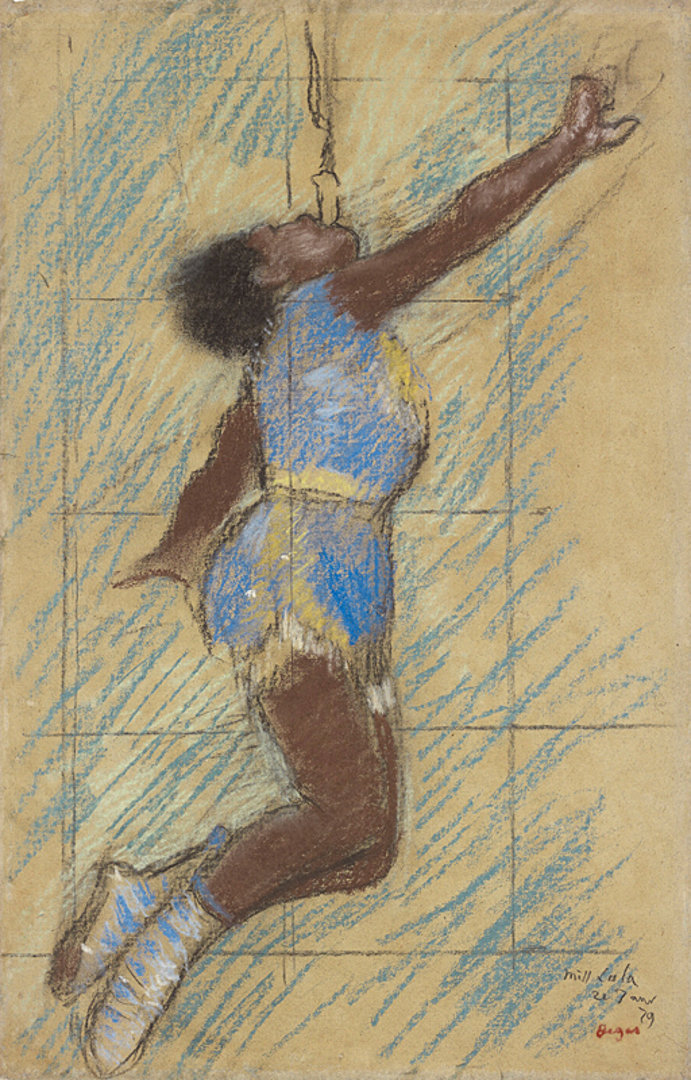'Discover Degas & Miss La La' will debut never-before-seen sketches by Degas and photographs of Miss La La
In June 2024, as part of the National Gallery’s free ‘Discover’ series, Degas’s Miss La La at the Cirque Fernando, 1879, takes centre stage. This landmark Impressionist painting records an extraordinary moment and features a remarkable sitter – the circus artist Miss La La, (her stage name; she was born Anna Albertine Olga Brown, 1858‒1945). This exhibition will take a closer look at Degas’s painting and will reveal new information about Miss La La, her life and career to the public for the first time, including a number of never-before-seen photographs of Olga, as she was known to her friends and family.
In January 1879 French painter Edgar Degas attends performances at the newly built Cirque Fernando in Paris. There, he is mesmerised by the dexterity and technical prowess of star acrobat Miss La La, full of poise and grace, and about to reach international fame. Degas makes her the subject of one of his most original and arresting paintings, capturing her in possibly one of her most striking and perilous acts – when, suspended from a rope clenched between her teeth, she spirals towards the circus ceiling.
Among all other works shown at the 4th Impressionist Exhibition in Paris in April 1879, the painting is no doubt one of the most uncompromisingly daring and modern. A significant ensemble of Degas’s preparatory drawings, reunited for this exhibition, shows him at work, observing and sketching this remarkably talented sitter. These include a large drawing of Miss La La – last published over a hundred years ago – with her profile delineated three times. In addition, two newly discovered, unpublished drawing by Degas are displayed: a rare sketch of Miss La La depicted against the circus architecture, hanging from its vertiginous rafters and an entirely unknown drawing of her stage partner Theophilia, from the ‘Miss La La and the Kaira Troupe’, also posing for Degas.
Born in Szczecin, Prussia (now Poland) to a European mother and an African-American father, Olga’s racial identity, both as a performer and a person, will be addressed in the exhibition. Showcasing recent research into Black models, the exhibition will restore Miss La La’s name – Anna Albertine Olga Brown – redressing the historic anonymity of non-white sitters. A selection of posters will attest to Olga’s brilliant career, the extent of which had until recently not been fully grasped – and her immense success in France, England and beyond. Newly discovered photographs of Olga depict her as a successful aerialist, in her acrobat outfit, posing next to props or her circus partners. Other photographic portraits of her, also unveiled here for the first time, show multiple facets of her life outside of her work. They show Olga as a woman in society, as well as her later life as a successful circus manager and as a family woman.
Focusing on one of Degas’s masterpieces, and his only painting depicting a non-white sitter whose identity is known, the exhibition will also look at how Degas himself represented and related to people of colour. Although he was himself the son of a Creole mother (of European descent) and was fascinated by the ethnic diversity he saw during a trip to New Orleans in 1872‒73, Degas is believed to have only painted two works representing people of colour. Drawing on recent academic research, a section of the show will investigate his complex relationship to the representation of race.
As the painting, acquired for the nation in 1925 thanks to the Courtauld Fund, is about to celebrate 100 years in the collection of the National Gallery, the exhibition also looks at how it influenced and inspired British art in the 1920s. Works by artists such as Thérèse Lessore and Duncan Grant form the final section of the exhibition, looking at how 'Miss La La at the Cirque Fernando' inspired British artists after the First World War and beyond.
Featuring new material, from hitherto untraced drawings of her by Degas, to entirely unpublished photographic portraits, and showcasing ground-breaking new research, the exhibition casts a frank, direct light on Anna Albertine Olga Brown, while inviting us to look afresh at the painting 'Miss La La at the Cirque Fernando'. Its particular resonance today will be emphasised, engaging our visitors with an inspirational story not previously told at the National Gallery. This is the third in a series of ‘Discover’ exhibitions, which explore lesser-known masterpieces in a new light. Other exhibitions in this series include Discover Manet & Eva Gonzalès and Discover Liotard & The Lavergne Family Breakfast.
Anne Robbins, lead curator of 'Discover Degas & Miss La La', says: 'Working on this exhibition has been an incredible adventure, with so many new discoveries – about Miss La La herself, about Degas’s working process and about his complex approach to his model, Olga Brown. We cannot wait to share with the public this fascinating information, and these stunning artworks which have never been seen or published before. They change the way we look at this painting and its extraordinary sitter forever.'
Exhibition supported by
The Thompson Family Charitable Trust

The Sunley Room exhibition programme is supported by the Bernard Sunley Foundation
Notes to editors
Image credits
NG4121
Hilaire-Germain-Edgar Degas
'Miss La La at the Cirque Fernando', 1879
Oil on canvas
117.2 × 77.5 cm
The National Gallery, London
X11896
Hilaire-Germain-Edgar Degas
'Miss La La at the Cirque Fernando', 1879
Pastel
46.4 x 29.8 cm
The J. Paul Getty Museum, Los Angeles, California (2004.93)
Digital image courtesy of the Getty's Open Content Program
Press view: Tuesday 4 June 2024
The National Gallery is one of the greatest art galleries in the world. Founded by Parliament in 1824, the Gallery houses the nation’s collection of paintings in the Western European tradition from the late 13th to the early 20th century. The collection includes works by Artemisia Gentileschi, Bellini, Cezanne, Degas, Leonardo, Monet, Raphael, Rembrandt, Renoir, Rubens, Titian, Turner, Van Dyck, Van Gogh and Velázquez. The Gallery’s key objectives are to care for and enhance the collection and provide the best possible access to visitors. Admission free.
On 10 May 2024 the National Gallery will be 200 years old, and we will start our Bicentenary celebration, a year-long festival of art, creativity and imagination, marking two centuries of bringing people and paintings together.
The Bernard Sunley Foundation
The Sunley Room was established at the National Gallery in 1984 and the Foundation has supported the exhibition programme in the Sunley Room every year since 1990. The Bernard Sunley Foundation is a family grant-making foundation which supports charities in England and Wales that deliver a real community focus and provide greater opportunities for the young, the elderly, the disabled and the disadvantaged.
More information at nationalgallery.org.uk
X, formerly Twitter @nationalgallery
Facebook @thenationalgallery
Instagram @nationalgallery
YouTube @nationalgallery
TikTok @nationalgallerylondon
Threads @nationalgallery
Press enquiries
National Gallery Press Office on 020 7747 2865 or email press.external@nationalgallery.org.uk
Publicity images can be obtained from https://press.nationalgallery.org.uk/


